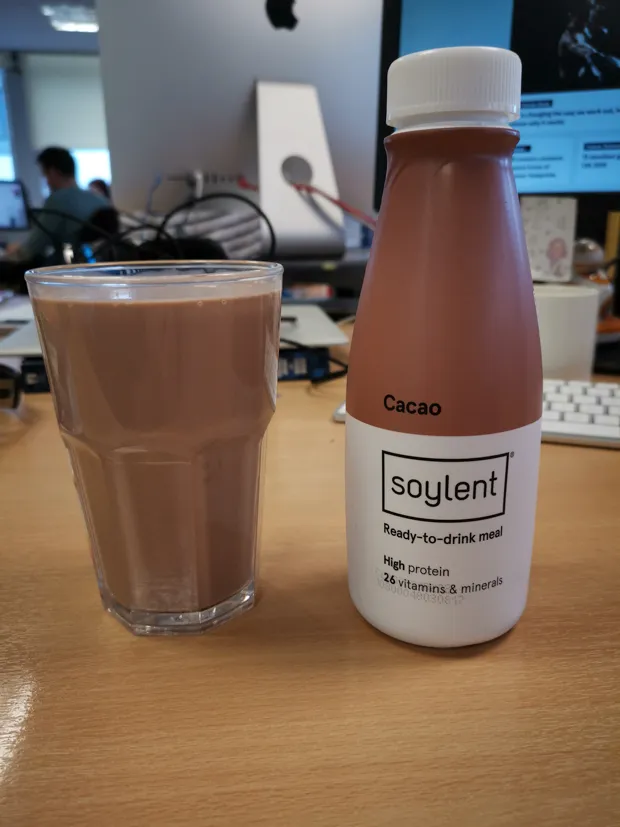Update 10/07/2019: Soylent is now available in the UK in its powdered form. This article has been updated.
Lunch, anyone? Not today my solid-food loving friend. I’ve got a fridge full of Soylent with my name on it.
Soylent, eh – care to elaborate on what’s getting between us and that date with a burger? Well, to put it simply, Soylent is a massively popular meal-replacement drink on the other side of the pond. It’s designed to provide “maximum nutrition with minimal fuss or hassle”.
How much fuss and hassle are we saving here? Loads, especially if you consider cooking to be an unnecessary evil in these days of takeaways and instant noodles. Up until September last year, the drink was available only in the United States, but now you can get Soylent in the UK in premixed 414ml bottles from Amazon UK, so it’s just a case of cracking one open and glugging it down. Knives and forks stay safely tucked away in the cupboard.
And that one drink counts as a full meal? Apparently so. One bottle contains 20g of plant protein, 26 vitamins and minerals, and tips the scales with about 400 calories.
Well that does sound easy, but I have so, so many questions… Great, so did I, which is why peppered Soylent CEO Bryan Crowley with them.

For a start, why…? Why indeed. Crowley says the story began back in 2013, when the company’s founder Rob Reinhart worked 18-hour days as a software engineer living off ramen and peanut butter sandwiches. Instead of just, you know, picking up an apple, he thought that there must be a better, more efficient way of eating, so he taught himself food science with the aim of inventing a powder that could deliver all the nutrition he needed in an affordable and convenient way.
Rhinehart blogged about living on only Soylent for 30 days, it went viral, and led to one of the most successful crowdsourcing campaigns of all time, raising nearly $1.5 million.
Blimey, talk about taking one for the team. Does this mean we need never eat again? Woah, hold on there. I for one like to eat; a sentiment shared by the folks at Soylent. They don’t recommend living off nothing but Soylent (although many, many people on the internet seem to think it sounds like a good idea), but say it is instead designed to fill “food voids”.
Food voids? Yep, those times in between meals when you reach for a packet of crisps, or are late-night gaming and get a pizza delivered. Basically, those times when you know you really should eat some fruit or a balanced meal, and you blow it.
Crowley reckons there are about 6-10 times a week that we choose something unhealthy or skip a meal altogether, and Soylent is designed to slip into that ‘void’ to give you something healthy.

And is it? Sure. I mean on the face of it all the good stuff is in there, but to be sure we asked BBC Focus columnist and author of The Fast 800 Dr Michael Mosley. He reassured me that there have been “plenty of studies where people have stayed on them quite healthily for 20 weeks or more.”
What’s more, the science behind using shakes as meal replacements is pretty robust. “There was a big study in 2018 which showed how effective shakes can be,” Mosley told me. “The study, called DIRECT, involved 298 patients with type 2 diabetes in GP practices in Scotland or the north of England being allocated either 800 calories in shakes for at least 12 weeks, before moving gradually to real food, or getting standard advice.
“Those who went the shake route lost an average of 10kg and kept it off for at least a year; almost half put their diabetes into remission. The control group lost 1kg and none put their diabetes into remission.”
Sounds pretty healthy to me.

Nom nom, so what’s in it? Well the ingredients list is filled with things that look like they have been buried at the back of a food scientist’s lab for a while, but the main ingredient is, maybe unsurprisingly given the name, soy. Crucially though, the UK recipe has been tweaked so that it complies with EU food standards and dietary recommendations, and removes some of the genetically-modified (GM) ingredients that are found in the US variant.
That’s a good thing, right? Well that depends on where you stand on the GM food debate. It doesn’t take a genius to notice that in the UK we’ve not welcomed GM with open arms, which is why there are seven different, non-genetically modified ingredients in Soylent over here than in the US formula.
But as Crowley sees it, they are proudly GM. “We think this is a great way to ensure we have the least impact on the environment, and maximises the nutrition and value for money for the consumer.” With 9.7 billion people to feed by 2050, he reckons this is one way we can begin to solve the problem.
Couldn’t we just eat more fruit and veg? Let’s be honest, we know we should be getting our five-a-day, but how many of us actually do that? (29 per cent apparently) Although Soylent isn’t looking to replace all of your meals, chugging one down instead of pizza will ultimately do all of us a world of good, especially if it can help nudge us away from snacking in general.
That’s a sentiment shared by Mosley, whose initial scepticism about meal replacement shakes has changed. “As so much food you have access to outside the home is junk food, nutritionally deficient, I can see that people may prefer a shake that they know contains balanced nutrients.”
That’s one reason why Soylent have teamed up with the British esports team Endpoint in order to get their product under the noses of the notoriously snack-happy gaming market.
So let’s get down to brass tacks, does it make for a good meal? Well, I’m not going to lie – it’s not going to replace that burger any time soon. There is something about the thought of chewing that really gets the juices going more than slurping down a shake, but it is surprisingly filling, and I’ve not really been left wanting food until a good three or four hours afterwards.
That makes it particularly handy if you regularly rush out the door and skip breakfast, or have up all night playing FIFA or, erm, trying to finish a feature before deadline, and you need something that isn’t a cheeky pasty.
There are three flavours at the moment, which range in deliciousness, the best by far being Cacao, tasting alarmingly like a particularly unhealthy milkshake from everyone’s favourite fast-food burger joint. The Original flavour is not for me, and the Café Mocha is like, perhaps unsurprisingly, slurping down a thick mocha (sans caffeine).
Though when it comes to texture, there’s definitely something ‘different’ about them compared to your standard drink (whatever that is), so it’s probably worth trying one out before you drop nearly £40 on a pack of 12.
Alternatively you can also pick up Soylent in powdered form, which means you can thicken the drink up to your own liking (and is a bit cheaper at around £2.40 per meal compared to £3.25 per bottle). There are two flavours to pick from; Cacao, which is pretty much the same as the premixed, and Original, which i described to a friend as "liquid texture". Not the most flattering of descriptions, but it does mean you can blend it with anything to zhush up the flavour. I blew all element of calorie control out of the water by throwing in a banana and some peanut butter.

Hmm, Cacao is not really my thing, are there any alternatives? Chocolate shake not really your thing?!? Pft, anyway, if you’re a millennial or younger, you’ve probably seen Huel adverts popping up on every single one of your social feeds recently. They are the UK’s home-grown equivalent to Soylent, and although they have recently started selling premixed bottles, their model has thus far been in powdered form, which you shake up in a bottle with some water and add in flavour boosts (things like banana, chocolate or matcha tea).
I’ve tried this one too (I’ll do anything for science), and although mixing it up yourself is a bit more effort, you can tweak the texture and flavour to your liking, again, with varying degrees of tastiness (Toffee good, Mint-Chocolate bad).
Right, well I’m still hungry, and all this chit-chat has used up my lunch break. Soylent, anyone?
Follow Science Focus onTwitter,Facebook, Instagramand Flipboard
